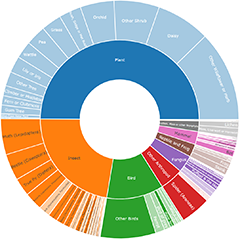Lilies & Irises
This group includes any herbaceous monocot that has prominent flowers in which the flower parts are in two whorls. Monocots have one seed leaf compared to two in dicotyledons. Mature plants are recognised by parallel longitudinal veins in their often narrow leaves and by having flowers parts in threes or multiples of three.
Identification is largely on differences in flower parts, the number of flowers borne at each part of the stem from which a leaf is attached or on the form of basal leaves. Ideally records for lilies and irises should include close-up photographs of the flowers and basal leaves and a shot that shows flower arrangement along the stem.
Announcements
There are currently no announcements.
Discussion
sangio7
wrote:
30 Nov 2025
Identified by comparison with sighting 4712540 and 4713245
Caesia calliantha
JaneR
wrote:
20 Nov 2025
Noted.
there is an inconsistency in the database. Schelhammera multiflora is under Wildflowers etc.
there is an inconsistency in the database. Schelhammera multiflora is under Wildflowers etc.
Schelhammera undulata
JasonPStewart
wrote:
20 Nov 2025
@JaneR . Good morning .
Thank you for your sighting, including wonderful photographs and correct identification.
However, in the different sub-category: Lilies and Irises, within the Plants (category), you will come across _Schelhammera undulata_ (species taxon) already set up in the NatureMapr taxonomy (not a new taxon for NatureMapr taxonomy) .
Thank you for your sighting, including wonderful photographs and correct identification.
However, in the different sub-category: Lilies and Irises, within the Plants (category), you will come across _Schelhammera undulata_ (species taxon) already set up in the NatureMapr taxonomy (not a new taxon for NatureMapr taxonomy) .
Schelhammera undulata
Significant sightings
- Thelionema umbellatum at Tinderry, NSW
- Dianella tarda at Castlemaine, VIC
- Dianella amoena at Barrington Tops, NSW
- Iris orientalis at Cooma North Ridge Reserve
- Dianella tarda at Suttons Dam
- Ornithogalum umbellatum at Watson, ACT
- Doryanthes excelsa at Fingal Bay, NSW
- Burchardia umbellata at Hackett, ACT
- Arthropodium glareosorum at Moruya, NSW
- Arum italicum at West Albury, NSW
Top contributors
- MichaelBedingfield 347
- trevorpreston 332
- Mike 313
- Tapirlord 259
- sangio7 228
- KylieWaldon 191
- Darcy 161
- AaronClausen 142
- MatthewFrawley 135
- JaneR 129
Top moderators
- MichaelMulvaney 1.5K
- Tapirlord 1.4K
- MichaelBedingfield 1.1K
- BettyDonWood 569
- natureguy 416
- RWPurdie 237
- plants 220
- Darcy 215
- Venture 165
- JasonPStewart 105




















































